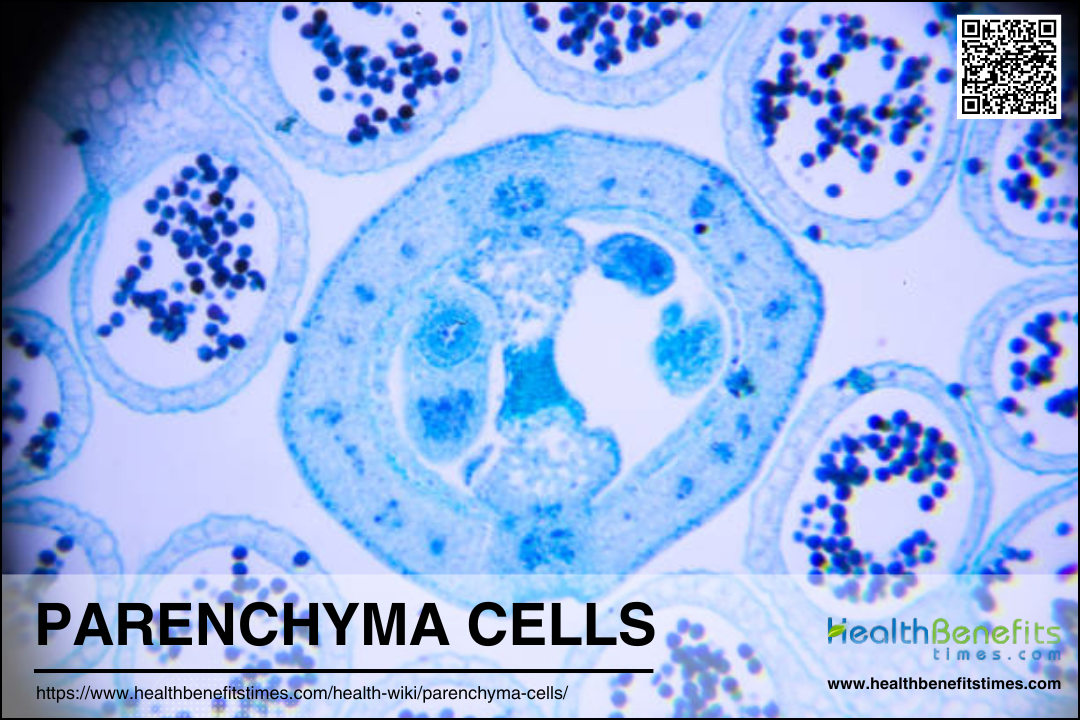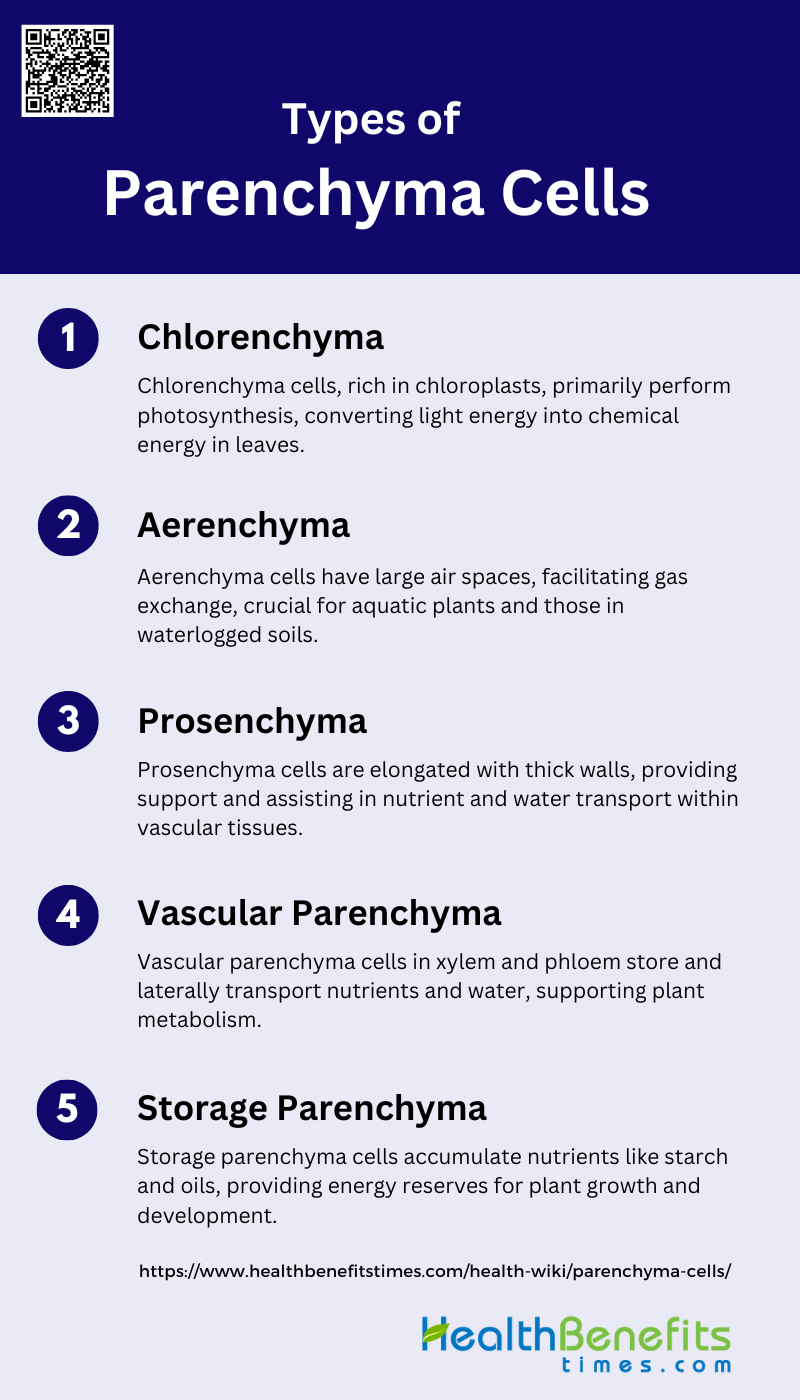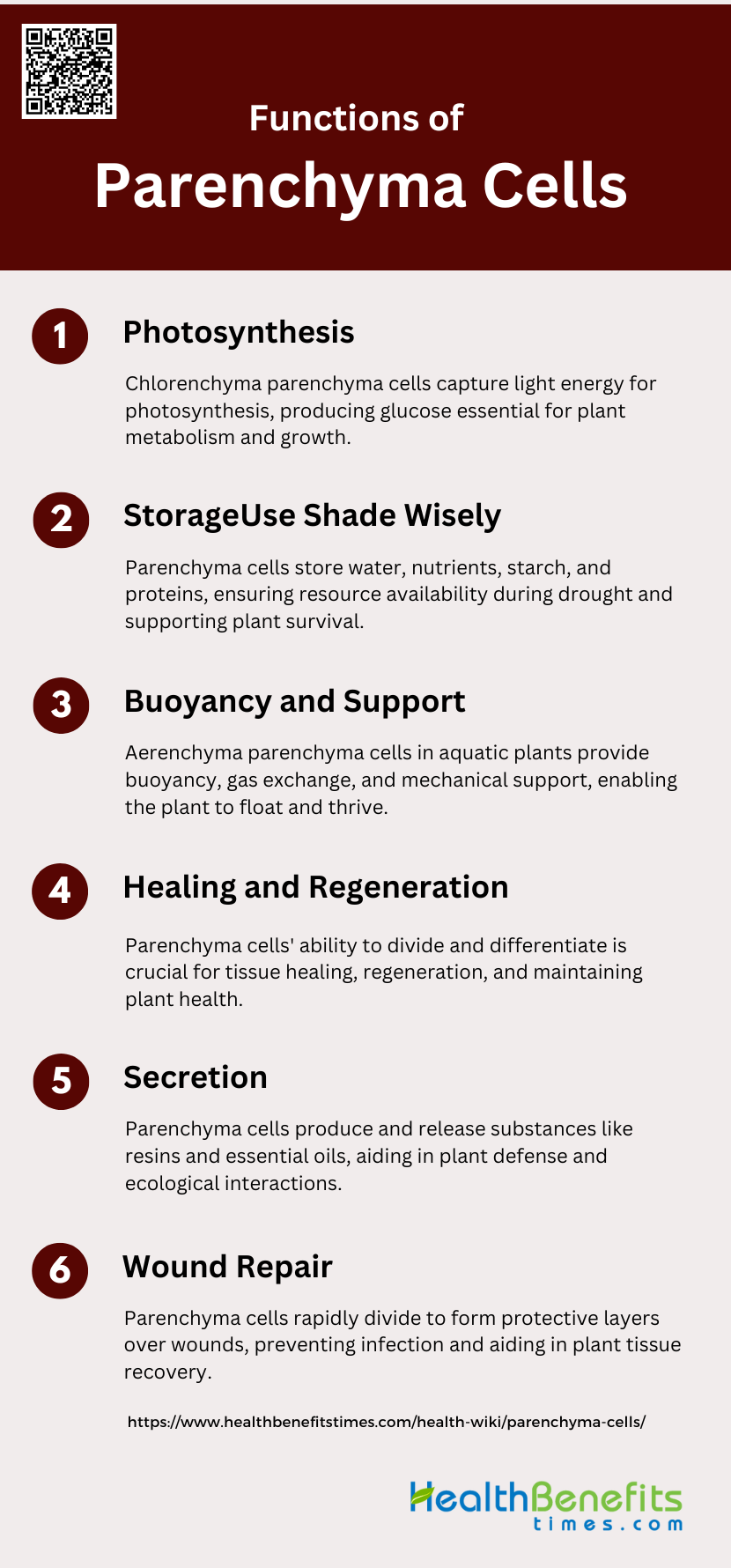Parenchyma cells are a type of plant cell that are fundamental to the structure and function of plants. They are the most common and versatile cells found in plant tissues, playing crucial roles in photosynthesis, storage, and tissue repair. These cells are typically characterized by their thin cell walls and large central vacuoles, which allow them to store water, nutrients, and other substances. Parenchyma cells are found in various parts of the plant, including the leaves, stems, roots, and fruits. In leaves, they are involved in photosynthesis, while in roots and stems, they often store starch and other nutrients. Additionally, parenchyma cells can differentiate into other types of cells, contributing to the plant’s ability to heal and regenerate tissue after injury. Their ability to divide and adapt makes them essential for plant growth and development.
Types of Parenchyma Cells
Parenchyma cells are fundamental components of plant tissues, playing various roles in plant physiology. They are versatile and can be found in different parts of the plant, each type serving a unique function. Below are the main types of parenchyma cells and their specific roles within the plant structure.
1. Chlorenchyma
Chlorenchyma cells are specialized parenchyma cells that contain chloroplasts and are primarily involved in photosynthesis. These cells are typically found in the mesophyll of leaves and in the outer layers of stems, where they capture light energy and convert it into chemical energy through the process of photosynthesis. Chlorenchyma cells lack the thickened cell walls found in collenchyma and sclerenchyma cells, making them more flexible and better suited for their role in photosynthesis.
2. Aerenchyma
Aerenchyma is a type of parenchyma tissue characterized by large intercellular air spaces that facilitate gas exchange. This tissue forms as an adaptation to submergence and is commonly found in aquatic plants and plants growing in waterlogged soils. Aerenchyma reduces internal impedance to the transport of gases such as oxygen, nitrogen, and carbon dioxide, thereby preventing asphyxiation and promoting root oxygenation and oxidative detoxification of the rhizosphere. It is particularly prevalent in the roots and stems of plants like rice.
3. Prosenchyma
Prosenchyma cells are elongated parenchyma cells that are specialized for support and conduction within the plant. Unlike other parenchyma cells, prosenchyma cells have thicker cell walls and are more elongated, which allows them to provide structural support while still being involved in the transport of nutrients and water. These cells are often found in vascular tissues, where they play a crucial role in the conduction of water and nutrients.
4. Vascular Parenchyma
Vascular parenchyma cells are found within the vascular tissues of plants, specifically in the xylem and phloem. These cells are involved in the storage and lateral transport of nutrients and water. In the xylem, they help in the storage of water and minerals, while in the phloem, they assist in the storage and transport of organic nutrients. Vascular parenchyma cells are essential for maintaining the plant’s overall nutrient balance and supporting its metabolic functions.
5. Storage Parenchyma
Storage parenchyma cells are specialized for the storage of nutrients such as starch, oils, and other carbohydrates. These cells are commonly found in roots, tubers, seeds, and stems, where they store energy reserves that the plant can utilize during periods of low photosynthetic activity or during germination. The stored materials in these cells are crucial for the plant’s growth and development, providing a readily available source of energy and nutrients.
Structure of Parenchyma Cells
Description of the Typical Morphology
Parenchyma cells exhibit a variety of shapes and sizes depending on their location and function within the plant. In apple parenchyma, cells near the periphery are radially flattened or spherical, measuring about 50 µm in diameter, while those towards the interior are larger (up to 300 µm in diameter) and radially elongated, forming radial columns. This anisotropic nature, where cell morphology changes from the outside to the inside, is a common feature in many plant tissues. The cells are often organized into columns with intercellular spaces that vary in size and shape, contributing to the overall structure and function of the tissue.
Cell Wall
The primary cell wall of parenchyma cells is primarily composed of cellulose, hemicelluloses, and pectins, which provide structural support and flexibility. In maize, the primary cell wall microfibrils are organized into parallel arrays, forming a network that includes both crystalline and subcrystalline structures. This arrangement allows for the deposition of other cell wall components, such as hemicelluloses and pectins, which embed the microfibrils and contribute to the wall’s mechanical properties. The primary cell wall is essential for maintaining cell shape, mediating cell growth, and facilitating intercellular communication through plasmodesmata.
Cytoplasm and Organelles
Parenchyma cells contain all the typical organelles found in plant cells, including mitochondria, endoplasmic reticulum, ribosomes, dictyosomes (Golgi apparatus), and plastids. These organelles are involved in various metabolic processes, such as energy production, protein synthesis, and storage of starch and lipids. During certain physiological processes, such as redifferentiation into tracheary xylem elements, parenchyma cells exhibit a high concentration of organelles and associated vesicles within cytoplasmic bands. This dense granulation is indicative of the cell’s active metabolic state and its role in supporting the plant’s growth and development.
Intercellular Spaces
Intercellular spaces in parenchyma tissues play a crucial role in facilitating gas exchange, nutrient transport, and overall tissue flexibility. In apple parenchyma, these spaces vary in size and shape, with spherical spaces near the periphery and elongated spaces towards the interior. The presence of intercellular pectic strands, which connect cells in a ladder-like configuration, further enhances the structural integrity and communication between cells. These spaces and connections are essential for maintaining the physiological functions of the tissue, allowing for efficient movement of gases, water, and nutrients, and contributing to the plant’s overall health and growth.
Functions of Parenchyma Cells
Parenchyma cells are essential for various physiological processes in plants, contributing to growth, storage, and photosynthesis. These cells are highly adaptable and can differentiate to perform specific functions. Below are the key functions of different types of parenchyma cells.
1. Photosynthesis
Parenchyma cells, particularly chlorenchyma, play a vital role in photosynthesis. These cells are rich in chloroplasts, which are essential for capturing light energy and converting it into chemical energy through photosynthesis. Chlorenchyma cells are primarily located in the mesophyll of leaves, where they facilitate the absorption of sunlight and the exchange of gases necessary for photosynthesis. This process is crucial for the plant’s energy production, as it generates glucose, which serves as a primary energy source for the plant’s metabolic activities and growth.
2. Storage
Parenchyma cells are integral to the storage of water, nutrients, and other essential substances. They store starch, oils, and proteins, which can be mobilized when the plant requires energy or nutrients. The large central vacuoles of these cells allow them to store significant amounts of water, helping the plant maintain turgor pressure and survive during periods of drought. This storage capability is vital for plant survival and growth, as it ensures a steady supply of resources even in unfavorable conditions.
3. Buoyancy and Support
In aquatic plants, a specialized form of parenchyma known as aerenchyma provides buoyancy and support. Aerenchyma cells have large air spaces that facilitate the exchange of gases between the plant and its environment, which is crucial for respiration and photosynthesis in submerged conditions. These air spaces also contribute to the plant’s buoyancy, allowing it to float and remain upright in water. Additionally, parenchyma cells contribute to the structural stability of plants by filling spaces between other tissues and providing mechanical support.
4. Healing and Regeneration
Parenchyma cells possess the ability to divide and differentiate, making them essential for healing and regeneration in plants. When a plant is injured, parenchyma cells at the wound site can proliferate and replace damaged tissues, facilitating recovery. This regenerative capacity is crucial for the plant’s lifecycle and health, as it enables the plant to recover from physical damage and continue growing. The ability of parenchyma cells to adapt and transform into other cell types underscores their importance in maintaining plant vitality.
5. Secretion
Parenchyma cells are involved in the production and release of various substances, including resins, gums, and essential oils. These secretions can serve multiple functions, such as deterring herbivores, attracting pollinators, or protecting against pathogens. The secretion process involves the synthesis of compounds within the parenchyma cells and their subsequent transport to the cell surface or specialized secretory structures. This function highlights the versatility of parenchyma cells in contributing to the plant’s defense mechanisms and ecological interactions.
6. Wound Repair
Parenchyma cells play a crucial role in the plant’s wound repair processes. When a plant is wounded, these cells can quickly divide and form a protective layer over the damaged area, preventing further injury and infection. This response is part of the plant’s innate healing mechanism, allowing it to seal wounds and restore tissue integrity. The ability of parenchyma cells to rapidly proliferate and differentiate into various cell types is essential for effective wound healing and the overall resilience of the plant.
Parenchyma Cells Comparison with Other Plant Cells
Contrast with Xylem and Phloem Cells
Parenchyma cells differ significantly from xylem and phloem cells in both structure and function. Xylem cells, primarily tracheids and vessel elements, are specialized for water transport and have thick, lignified walls that provide structural support but are dead at maturity. Phloem cells, including sieve elements and companion cells, are involved in the transport of nutrients and have soft walls that can collapse easily, making them less durable over time. In contrast, parenchyma cells are living cells with thin walls and are involved in various functions such as storage, photosynthesis, and tissue repair. They form a three-dimensional lattice that supports long-distance transport and resource partitioning in plants.
Unique Properties and Roles of Parenchyma Cells Compared to Other Tissues
Parenchyma cells possess unique properties that distinguish them from other plant tissues. They are versatile, living cells with thin, flexible walls, allowing them to perform multiple roles such as storage, photosynthesis, and wound healing. Unlike xylem and phloem cells, parenchyma cells maintain their metabolic activity throughout the plant’s life. They are crucial in secondary vascular tissues, forming an interconnected network that supports long-distance transport and resource allocation. Additionally, parenchyma cells in the xylem, known as vessel-associated cells (VACs), play specialized roles in osmoregulation, defense against pathogens, and possibly even surfactant production to facilitate water transport under negative pressure. These diverse functions underscore the importance of parenchyma cells in maintaining plant health and functionality.
Parenchyma Cells Significance in Agriculture and Ecology
Role in Crop Yield and Quality
Parenchyma cells play a crucial role in crop yield and quality by serving as storage sites for essential nutrients and photosynthates. In large grasses like sugarcane and sweet sorghum, stem parenchyma cells store significant amounts of sucrose, which is vital for the plant’s energy needs and overall growth. Additionally, the phloem parenchyma cells are integral in the distribution of sugars and amino acids to various sink tissues, directly impacting crop yield and food security. By understanding and manipulating the metabolic functions of parenchyma cells, researchers can enhance crop performance and yield potential, making them a focal point in agricultural biotechnology.
Contribution to Ecological Balance and Plant Adaptation
Parenchyma cells contribute to ecological balance and plant adaptation by participating in nutrient translocation and storage, which are essential for plant survival in varying environmental conditions. Despite the variability in parenchyma abundance among species, these cells are involved in critical metabolic functions such as nutrient storage and translocation, which help plants adapt to different soil nutrient profiles. For instance, species from low-nutrient soils exhibit higher phosphorus translocation, indicating an adaptive mechanism facilitated by parenchyma cells. Moreover, the anatomical composition of wood tissue, including parenchyma cells, plays a role in the plant’s hydraulic functions and overall ecological strategies, although the exact ecological significance remains to be fully understood.
FAQs
1. Are parenchyma cells found only in plants?
Parenchyma cells are a fundamental type of cell primarily found in plants. However, the term “parenchyma” is also used in zoology to describe functional tissues in animals, such as in the liver or lungs, though these tissues differ significantly from plant parenchyma cells.
2. How do parenchyma cells contribute to the longevity of plants?
Parenchyma cells contribute to the longevity of plants by maintaining their ability to divide and differentiate throughout the plant’s life. This allows plants to repair damaged tissues, adapt to environmental changes, and continue growing even after injuries.
3. Can parenchyma cells regenerate after they have been damaged?
Yes, parenchyma cells have the ability to regenerate after damage. They can proliferate and differentiate into various types of cells to repair wounds and replace damaged tissues, aiding in the plant’s healing process.
4. What role do parenchyma cells play in the defense mechanisms of plants?
Parenchyma cells are involved in the production and secretion of various substances, such as resins, gums, and essential oils, which can deter herbivores, attract pollinators, or protect against pathogens, contributing to the plant’s defense mechanisms.
5. How do environmental conditions affect the function of parenchyma cells?
Environmental conditions, such as light, water availability, and nutrient levels, can influence the function of parenchyma cells. For example, in waterlogged conditions, aerenchyma (a type of parenchyma) develops to facilitate gas exchange and prevent asphyxiation.
6. Are there any genetic modifications in agriculture that target parenchyma cells?
Genetic modifications in agriculture often target parenchyma cells to enhance traits such as nutrient storage, stress tolerance, and disease resistance, thereby improving crop yield and quality.
7. How do parenchyma cells differ between monocots and dicots?
While the general structure and functions of parenchyma cells are similar in both monocots and dicots, their arrangement and specific roles can vary. For example, the distribution of parenchyma cells in vascular tissues might differ, affecting how nutrients and water are stored and transported.
8. Can parenchyma cells be used in plant tissue culture?
Yes, parenchyma cells are commonly used in plant tissue culture due to their ability to divide and differentiate. They can be cultured to regenerate entire plants or to produce specific plant tissues for research and agricultural applications.
9. How do parenchyma cells assist in the storage of toxins or waste products?
Some parenchyma cells can store waste products or toxins in their vacuoles, isolating them from the rest of the plant cells to prevent damage. This function helps the plant manage and detoxify harmful substances.
10. What is the significance of intercellular spaces in parenchyma cells?
Intercellular spaces in parenchyma tissues facilitate the movement of gases, water, and nutrients within the plant. They play a crucial role in processes like respiration and photosynthesis, as well as in maintaining tissue flexibility and structural integrity.




